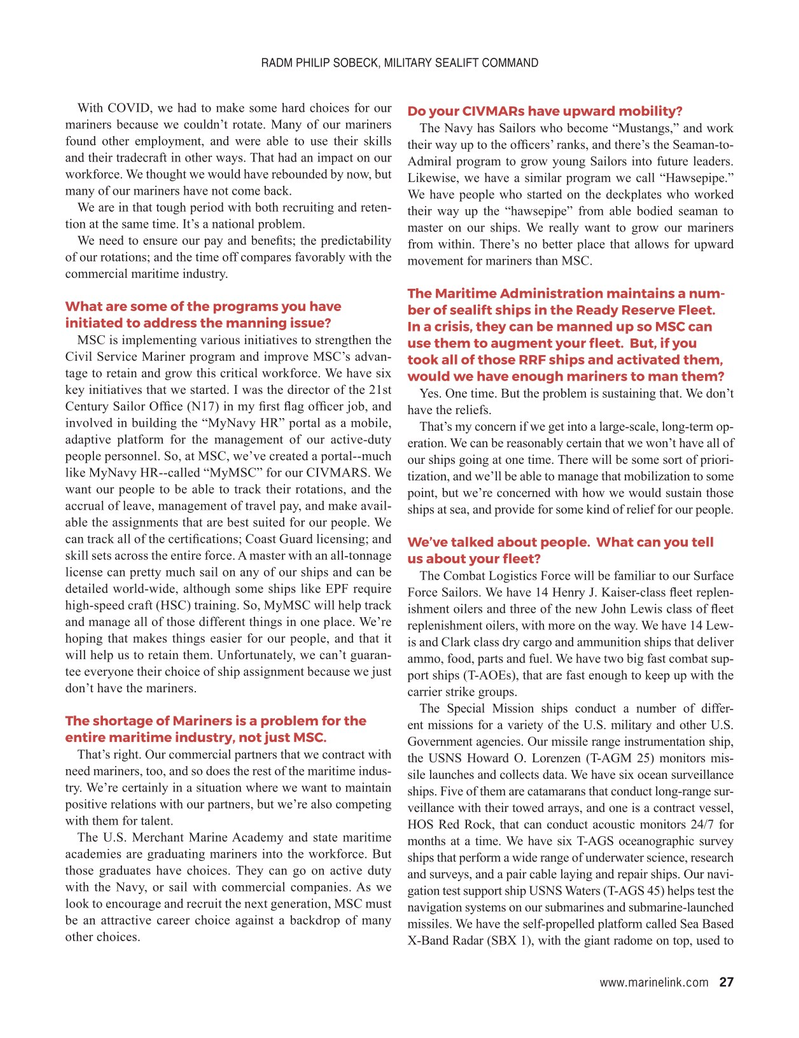
Page 27: of Maritime Reporter Magazine (April 2024)
Read this page in Pdf, Flash or Html5 edition of April 2024 Maritime Reporter Magazine
RADM PHILIP SOBECK, MILITARY SEALIFT COMMAND
With COVID, we had to make some hard choices for our Do your CIVMARs have upward mobility?
mariners because we couldn’t rotate. Many of our mariners
The Navy has Sailors who become “Mustangs,” and work found other employment, and were able to use their skills their way up to the of? cers’ ranks, and there’s the Seaman-to- and their tradecraft in other ways. That had an impact on our Admiral program to grow young Sailors into future leaders. workforce. We thought we would have rebounded by now, but
Likewise, we have a similar program we call “Hawsepipe.” many of our mariners have not come back.
We have people who started on the deckplates who worked
We are in that tough period with both recruiting and reten- their way up the “hawsepipe” from able bodied seaman to tion at the same time. It’s a national problem. master on our ships. We really want to grow our mariners
We need to ensure our pay and bene? ts; the predictability from within. There’s no better place that allows for upward of our rotations; and the time off compares favorably with the movement for mariners than MSC.
commercial maritime industry.
The Maritime Administration maintains a num-
What are some of the programs you have ber of sealift ships in the Ready Reserve Fleet. initiated to address the manning issue?
In a crisis, they can be manned up so MSC can
MSC is implementing various initiatives to strengthen the use them to augment your ? eet. But, if you
Civil Service Mariner program and improve MSC’s advan- took all of those RRF ships and activated them, tage to retain and grow this critical workforce. We have six would we have enough mariners to man them?
key initiatives that we started. I was the director of the 21st
Yes. One time. But the problem is sustaining that. We don’t
Century Sailor Of? ce (N17) in my ? rst ? ag of? cer job, and have the reliefs.
involved in building the “MyNavy HR” portal as a mobile,
That’s my concern if we get into a large-scale, long-term op- adaptive platform for the management of our active-duty eration. We can be reasonably certain that we won’t have all of people personnel. So, at MSC, we’ve created a portal--much our ships going at one time. There will be some sort of priori- like MyNavy HR--called “MyMSC” for our CIVMARS. We tization, and we’ll be able to manage that mobilization to some want our people to be able to track their rotations, and the point, but we’re concerned with how we would sustain those accrual of leave, management of travel pay, and make avail- ships at sea, and provide for some kind of relief for our people. able the assignments that are best suited for our people. We can track all of the certi? cations; Coast Guard licensing; and
We’ve talked about people. What can you tell skill sets across the entire force. A master with an all-tonnage us about your ? eet? license can pretty much sail on any of our ships and can be
The Combat Logistics Force will be familiar to our Surface detailed world-wide, although some ships like EPF require Force Sailors. We have 14 Henry J. Kaiser-class ? eet replen- high-speed craft (HSC) training. So, MyMSC will help track ishment oilers and three of the new John Lewis class of ? eet and manage all of those different things in one place. We’re replenishment oilers, with more on the way. We have 14 Lew- hoping that makes things easier for our people, and that it is and Clark class dry cargo and ammunition ships that deliver will help us to retain them. Unfortunately, we can’t guaran- ammo, food, parts and fuel. We have two big fast combat sup- tee everyone their choice of ship assignment because we just port ships (T-AOEs), that are fast enough to keep up with the don’t have the mariners.
carrier strike groups.
The Special Mission ships conduct a number of differ-
The shortage of Mariners is a problem for the ent missions for a variety of the U.S. military and other U.S. entire maritime industry, not just MSC.
Government agencies. Our missile range instrumentation ship,
That’s right. Our commercial partners that we contract with the USNS Howard O. Lorenzen (T-AGM 25) monitors mis- need mariners, too, and so does the rest of the maritime indus- sile launches and collects data. We have six ocean surveillance try. We’re certainly in a situation where we want to maintain ships. Five of them are catamarans that conduct long-range sur- positive relations with our partners, but we’re also competing veillance with their towed arrays, and one is a contract vessel, with them for talent.
HOS Red Rock, that can conduct acoustic monitors 24/7 for
The U.S. Merchant Marine Academy and state maritime months at a time. We have six T-AGS oceanographic survey academies are graduating mariners into the workforce. But ships that perform a wide range of underwater science, research those graduates have choices. They can go on active duty and surveys, and a pair cable laying and repair ships. Our navi- with the Navy, or sail with commercial companies. As we gation test support ship USNS Waters (T-AGS 45) helps test the look to encourage and recruit the next generation, MSC must navigation systems on our submarines and submarine-launched be an attractive career choice against a backdrop of many missiles. We have the self-propelled platform called Sea Based other choices.
X-Band Radar (SBX 1), with the giant radome on top, used to www.marinelink.com 27
MR #4 (18-33).indd 27 4/5/2024 8:26:14 AM

 26
26

 28
28
